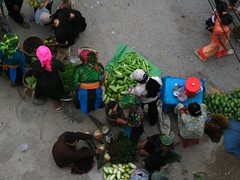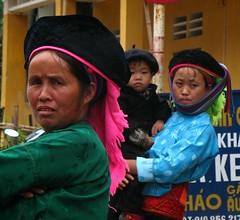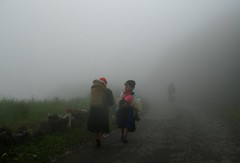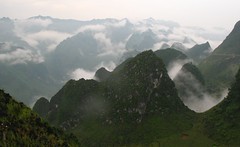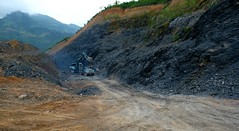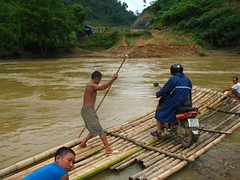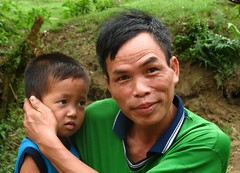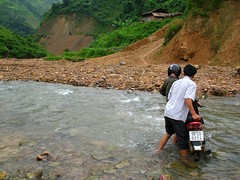Nhat Ky Xe Day 10: Yen Minh -> Meo Vac -> Bao Lac Approx. ???km
Yen Minh was a quiet town when we arrived the previous night. We had walked around for a couple hours in the evening hunting for food and had seen only a few dozen people. The next morning, though, the place had undergone a complete transformation. I woke up to the steady noise of the bustling market that had materialized overnight, completely surrounding our hotel. I walked out on the balcony and watched as hundreds of montagnards from the surrounding villages bought and sold food, housewares, medicines, livestock, clothing, instruments and furniture.
Michael and I paid the bill downstairs and wandered into the market to find some breakfast. I was already used to automatically being granted celebrity status just by being one of the only two foreigners in a small Vietnamese town, but here it was taken to a new level. We shuffled through the thick crowd of villagers - Tay, H’Mong, Dzao, Tai and others - each dressed up in their sunday best. The selection of prepared food and produce on sale at this market was similar to what I’d seen in Sa Pa. Fruits and vegetables found in cooler climates were available - plums, peaches, grapes - and the food stalls were serving only a few things that I recognized - raw pigs-blood soup, fried rice, some kind of simple noodle soup. Sorry to let down the weirdmeat fans, but I went for the noodle soup.
Michael and I sat down on a bench and ordered a bowl of soup each. All eyes were on us. I turned to see that a large audience had formed around us. The soup was nothing more than hot water, MSG, green onions, fish-sauce and fresh noodles, but we each finished our bowls to the last drop. A man sitting at the stall next to us whipped out his camera and recorded us pretending to be comfortable among the slack-jawed stares of the villagers around us. Every time I glanced over into his camera and smiled, the group of spectators that had assembled around him whooped with laughter. For a few minutes, we were fascinating, exotic animals in a crowded petting zoo, and everyone else was a tourist.
When we stood up to pay, they scrambled for a scrap of paper on which they could write out the price for us. When I waved a hand and said, in awkward Vietnamese, “No, Vietnamese please,” The food-stall lady’s eyes lit up and she spouted out a stream of questions, none of which I understood, of course. I smiled and said, “Only numbers. Sorry.” Bon ngin dong, she said with a smirk, expecting me to haggle her down from the foreigner price of $0.25 each. We gladly paid and walked out through the crowd, which parted for us as we went.
Everyone was as friendly as they were fascinated by us. Young boys approached us to shake hands and say Hello! Shop-owners were keen to win our business, knowing that a crowd of potential customers was sure to follow us to their stall. I bought some backup batteries for my camera before Michael and I decided it was time to get back on the bikes. We watched as old men staggered away to the road, barefoot, with 20kg sacks of rice strapped to their backs. The wealthier families crammed themselves and their purchases precariously onto overloaded motorbikes and putted off alongside us into the mountains.
The market had drawn hundreds of people from smaller villages of the surrounding countryside, and as we left many of them were already on their way back home. They walked along the road, most of them without shoes, carrying large bundles on their heads or in large woven baskets strapped to their backs; The roads were dotted with pedestrians all day long. We knew that today was going to bring some of the best scenery yet. It was 40km to Dong Van, which marks the start of the famous 20km stretch of road south to Meo Vac along the Chinese border. As I mentioned before, these are all “frontier areas,” and we spotted a few signs clearly announcing this in English, Vietnamese and Chinese. I noticed that the numbers on all of the milestones along the road in these areas have been erased (does anyone know why this is?)
I had mentally prepared myself to face some poor roads during this part of the ride, but we only hit a few short unpaved stretches. Sometimes the road would even mysteriously open up into a vast, smooth 4-lane highway for a stretch of only 500 meters and then switch back to normal as it snaked up the mountain. Eventually we passed through Dong Van and reached the climax of the trip: the last 20km to Meo Vac.
The road winds its way among towering karsts until it makes you a tiny dot overlooking an immense valley sprinkled with stilt-houses and terraced fields. The terrain, from the river far below up to the horizon, is a rough stack of purple layers dissapearing into the white mist. I stopped along the way often to stare out across the valley and shoot photos, but none of them do any justice to the view. I’m not sure, but I think that valley serves as part of the border between Vietnam and Yunnan, China.
During the last few minutes of the ride to Meo Vac, I saw some pretty weird things. A few times, we passed by men laying unconscious in the dirt along the road. Other villagers stepped over them nonchalantly, but I still have no idea what was going on with them. We also drove by a group of young girls (teenagers, I think) who were helping another girl walk. I slowed as we passed them and glanced at the girl who was having trouble walking. Her eyes were rolled back into her head and her body was flopping back and forth as she stumbled next to the other girls. One of her friends gave me an icy stare and waved me away. Michael and I agreed later that the unconscious men must have over-indulged in the opium that is produced all over the area, but we couldn’t come up with a story to explain that girl…
We stopped to discuss our next move in Meo Vac. From there our goal was to simply travel back to Hanoi and end the trip. We had two options: turn back and ride on the roads which we knew to be in good shape until we reached highway 3, which would take us easily back to Hanoi, or continue moving southeast, further away from beaten path, into Cao Bang province and connect with highway 4 to ride home. We chose Cao Bang. If I had known what we would have to endure over the next two days, I would have turned back without a second thought. But then the story would have ended here!
A few minutes out of Meo Vac, the road turned to shit. It started to rain again. Our pace slowed to a crawl along the muddy path until we reached obstacle #1: a construction team was in the middle of creating the very muddy path we were traveling on. We pulled up to one of the workers and tried to figure out what to do. When I indicated that we needed to get to Cao Bang, he thrust his thumb out toward the construction with a grunt and a smile. “We drive there?” I asked him. Yes, you go! We approached the backhoe which was blocking the way and shouted to the workers that we wanted to get through. They just laughed at us and gave a “go right ahead!” gesture. They weren’t even going to stop digging for a moment to let us through. We had to approach the spot where they were working and time our passage to avoid being smashed by the swinging arm of the backhoe (just like in Super Mario Brothers 3 where you have to run past those angry smasher-block guys). The workers shrieked with laughter as we clumsily bounced our bikes over the jagged shards of stone they had torn from the mountain. All I could think of was the flat tire for which I was long overdue. Somehow we made it over the construction site unscathed and through the vast mud-pit on the other side and eventually reconnected with something resembling a road.
We kept riding, verifying with each person we passed that we were still headed towards Cao Bang. Then we came to obstacle #2: the first river-crossing. Our map had become useless at this point - it was dated 1999 and showed only a couple of roads throughout Cao Bang province, neither of which we were anywhere near. We slid ourselves carefully down to the bank and were greeted by a wild-eyed fellow who offered to carry us and our bikes across the river. When I asked him the price he held up four fingers and said “Bon.” Four. “Bon Ngin?” I verified. Four thousand? Yes. No problem.
Michael went first. Shouting crazily, the guy instructed Michael to drive his bike into the center of the tiny bamboo raft and keep it balanced there by standing over it. The river was about 60 feet wide and had a swift current. Wading or swimming across was completely out of the quesiton. The ferry guys had strung a wire across the water and held onto it as they slowly took the rafts across, hand over hand. Another guy with a raft ferried me over without incident, and on the other side they both demanded payment with a smile and open hand. Forty thousand dong each. In the big picture, that’s not a lot of money. But it angered me that they lied about the price upfront. We argued over the price and finally met halfway. Everyone lightened up and we were introduced to the group of ferrymen and their children. I took some photos.
Some other customers appeared on the other bank, and they rushed over to shuttle them across. In the middle of river, one of the ferrymen lost his grip on the wire and fell into the water. The others laughed hysterically as he scrambled back onto his raft and narrowly avoided being swept into the rapids downstream by paddling frantically with his tiny bamboo oar. We watched until the excitement died down and then continued riding. The guys had frowned and pointed at our bikes when we asked which way was Cao Bang city. I know now what they were trying to tell us…
The river we had just crossed forms part of the border between the provinces of Ha Giang and Cao Bang. Apparently each province is responsible for maintaining its own roads, and they don’t believe in roads in Cao Bang. At least not of the sort I’m used to. We rode further, taking a couple random guesses at mysterious forks in the road, until we came to obstacle #3: the second river-crossing. This time there was no bridge, no ferries, nothing. We stopped to discuss our options for a minute. Turning back would force us to waste what few hours we had left of the day going back over the first two treacherous obstacles, but we were unsure about being able to get our bikes safely across the river. It was much smaller than the last one - only about 15 feet across and knee-deep in the middle, but a problem with our wimpy city-loving bikes.
After a few minutes, a local guy (about our age) came out of nowhere and offered to help us. We pushed Mike’s bike into the water first, with the engine still running. As soon as we reached the middle, it died and wouldn’t start again on the other side. A light panic set in as we felt a heavy storm coming in (it had been raining lightly the whole time). For about 30 minutes we tried to bring it back to life - drying out the ignition parts, tilting the bike back to drain the water from the exhaust - until finally our friend got it running again. We were more careful with my bike and managed to start it up right away on the other side. After thanking our new friend with a large tip, we got back on the dirt road and continued.
The daylight was beginning to fade and the rain was thickening, so we agreed to stop at the next town. After crossing some rickety, old, rotting bridges, we arrived in Bao Lac. Bao Lac has only one hotel, so the price was steep, but we were too tired to protest. After one of the longest, most exhausting and most exciting days of my life, I slept well. And then woke up to do it all over again the next day…
